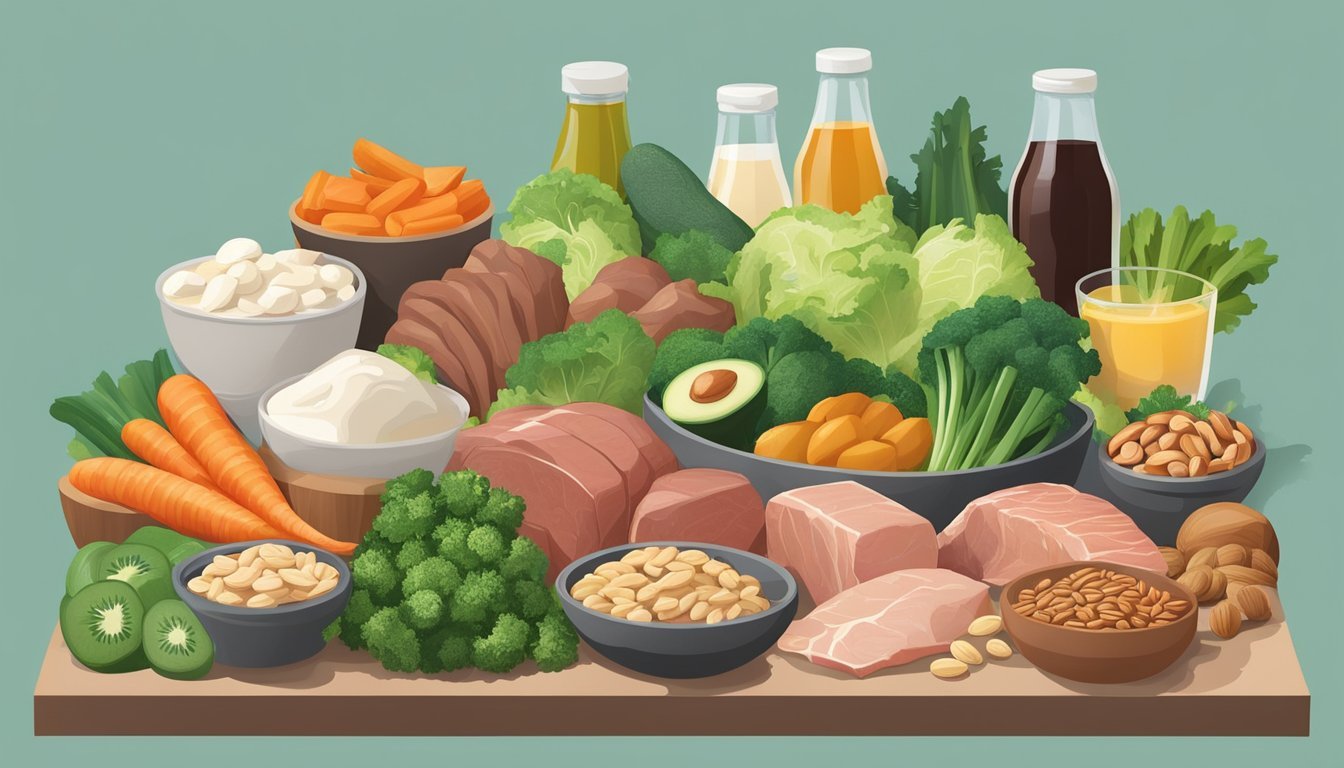Paleo Diet and Muscle Building
Top Foods for Optimal Muscle Growth
The Paleo diet, also known as the caveman diet, emphasizes consuming whole foods such as lean meats, eggs, fruits, vegetables, nuts, and seeds, while excluding grains, legumes, dairy, and processed foods. Originating from the dietary patterns of our Paleolithic ancestors, this dietary approach is reputed for its potential health benefits, which range from improved blood sugar levels to an enhanced capacity for weight loss. For those looking to build muscle, the high protein content centric to the Paleo diet provides the essential building blocks for muscle growth and repair.
Muscle building requires not just consistent training but also optimal nutrition. The Paleo diet's focus on protein-rich foods such as grass-fed beef, eggs, and wild-caught fish aligns with the nutritional needs of individuals aiming to gain muscle. Proteins are vital for muscle recovery after strenuous workouts and stimulate muscle synthesis, making them a key component of any muscle-building diet. Moreover, the Paleo diet's exclusion of processed foods and sugars means that individuals are less likely to consume empty calories, which can lead to increased fat accumulation rather than lean muscle gain.
In addition to protein, the diet provides other nutrients crucial for muscle development, such as omega-3 fats from seafood, which can help reduce inflammation and support muscle recovery. Iron and magnesium, found in nuts and leafy greens, play important roles in oxygen delivery to muscles and energy production, respectively. By adopting a Paleo approach to eating, individuals focused on muscle building can nourish their bodies with the high-quality, nutrient-dense foods necessary to support their training goals.
Understanding Paleo Diet Fundamentals
The Paleo diet emphasizes consuming whole, unprocessed foods, similar to what hunter-gatherers might have eaten, and excludes foods that became common with the advent of agriculture.
Key Principles of Paleo Eating
The core premise of the Paleo diet lies in eating foods presumed to have been available to Paleolithic humans. This includes:
Proteins: Lean meats, fish, and eggs are staples for their muscle-building potential.
Fruits and Vegetables: A wide variety for essential vitamins, minerals, and fiber.
Healthy Fats: Nuts, seeds, and oils like olive and coconut for balanced energy.
Exclusions: Grains, legumes, dairy, refined sugar, and processed foods are avoided due to their late introduction in human history through agriculture.
Paleo Diet Origins and Evolution
The Paleo diet is founded on the hypothesis that modern eating habits, shaped by the agricultural revolution, are mismatched with human genetics. This mismatch is thought to contribute to the prevalence of obesity, diabetes, and heart disease. The Paleo diet aims to rectify this by encouraging a return to the pre-agriculture era of high-protein and fiber intake, supposedly reflecting a diet more genetically suitable for the human body.
Comparison to Modern Diets
Compared to the typical Western diet, which often includes heavy amounts of processed foods and refined sugars, the Paleo diet restricts these components believing them to contribute to chronic diseases. Unlike low-carb diets, which may also limit grains and legumes, the Paleo diet distinctly focuses on the elimination of dairy and the high priority of whole, unprocessed foods. Its composition is often likened to the Mediterranean Diet, though the latter includes grains and dairy.
Essential Nutrients for Muscle Growth
Optimal muscle growth is dependent on a diet rich in essential nutrients. The Paleo diet emphasizes the consumption of whole foods, which naturally provides these necessary components for muscle development and repair.
Proteins and Amino Acids
Protein is crucial for muscle building because it contains amino acids, the building blocks of muscle tissue. Those following a Paleo diet typically consume a higher intake of protein through sources like:
Whole eggs: Supply complete proteins with all nine essential amino acids.
Lean meats: Include chicken, turkey, and grass-fed beef for high-quality protein.
Fish: Especially rich in protein and also provides omega-3 fatty acids.
It's important to distribute protein intake throughout the day to maximize muscle synthesis.
Healthy Fats and Their Role
Fats are essential for hormone production, including hormones like testosterone, which are vital for muscle growth. The Paleo diet includes healthy fats which contribute not only caloric density but also support overall health:
Avocados and nuts: Sources of monounsaturated fats.
Fish and fish oil: Provide omega-3 fatty acids, which have anti-inflammatory effects and support muscle recovery.
Coconut and olive oils: Serve as healthful cooking fats that remain stable at high temperatures.
Emphasizing fat quality over quantity is important for balancing energy needs with nutrient-dense options.
Vitamins and Minerals for Strength
Vitamins and minerals are required in various biochemical processes including muscle function and recovery:
Iron: Found in red meats, vital for oxygen transport to muscles.
Calcium: Abundant in leafy greens, necessary for muscle contractions.
Vitamins: Such as vitamin D, essential for calcium absorption and available in fatty fish and egg yolks.
A Paleo diet rich in vegetables and animal proteins naturally provides these nutrients, eliminating the need for processed food-based sources.
Best Paleo Foods for Muscle Building
Building muscle on a Paleo diet involves selecting foods that provide the nutrients needed for muscle growth, recovery, and overall health. Focus on high-quality proteins, healthful fats, and the right carbohydrates to fuel workouts and aid in the muscle-building process.
High-Protein Paleo Foods
The foundation of muscle building lies in adequate protein intake. Protein serves as the primary building block for muscle tissue, making it essential for growth and repair.
Eggs: Whole eggs provide complete protein and are rich in essential amino acids.
Meat: Options like grass-fed beef, lamb, and poultry supply the body with quality protein and important micronutrients.
Seafood: Fish such as salmon and sardines not only offer protein but also omega-3 fatty acids which are crucial for recovery.
Paleo-friendly Carbohydrate Sources
Carbohydrates are important for replenishing glycogen stores that are depleted during exercise. They provide the energy needed for high-intensity training.
Sweet Potato: A nutrient-dense carb source, sweet potatoes are ideal for post-workout recovery.
Fruits: Berries, bananas, and apples can offer a quick source of energy and are packed with antioxidants.
Vegetables: Non-starchy vegetables like cauliflower also contribute essential nutrients with minimal impact on blood sugar.
Fats for Energy and Health
Healthy fats are necessary for long-lasting energy and the absorption of fat-soluble vitamins.
Nuts and Seeds: Almonds, walnuts, and chia seeds are calorie-dense and provide both protein and healthy fats.
Avocado: Offers a creamy texture and is high in monounsaturated fats, beneficial for heart health.
Vegetables and Fruits for Recovery
Antioxidants in fruits and vegetables help combat exercise-induced oxidative stress, aiding recovery and muscle building.
Spinach: An excellent source of iron and magnesium, which are pivotal for muscle function and recovery.
Berries: Contain antioxidants that can help reduce inflammation and repair muscle tissues.
Designing a Paleo Muscle-Building Meal Plan
When creating a Paleo meal plan for muscle building, one must consider macronutrient balance, meal timing, and proper hydration. This approach ensures efficient muscle growth and recovery while adhering to Paleo dietary principles.
Balancing Macronutrient Intake
A Paleo meal plan should focus on a balanced intake of macronutrients to support muscle growth. This means:
Protein: The cornerstone of muscle repair and growth, essential choices include lean meats, eggs, and fish.
Carbohydrates: Should primarily come from fruits and vegetables to provide the needed energy for workouts while also delivering vital fiber.
Fats: Necessary for hormonal balance and as a dense energy source, one should incorporate sources like avocados, nuts, and seeds.
Macronutrient Sources
Protein Chicken, Lean Beef, Eggs, Seafood
Carbohydrates Sweet Potatoes, Berries, Leafy Greens
Fats Avocados, Almonds, Olive Oil
Meal Timing and Frequency
Timing meals around workouts is crucial for muscle fuel and recovery:
Pre-Workout: Consuming a balanced meal of protein and carbohydrates 2-3 hours before training can ensure adequate energy levels.
Post-Workout: It's important to eat within 45 minutes after exercising to maximize muscle recovery with protein and some carbohydrate-rich fruits.
Hydration and Electrolytes
Proper hydration is a must for overall health and optimal muscle function:
Water: Aim for at least 3 liters per day, with additional intake around workout times.
Electrolytes: They are lost during sweat and can be replenished with foods like bananas and hydration salts.
Maintaining mineral balance through adequate salt intake, especially for active individuals on a Paleo plan, is key to preventing muscle cramps and facilitating hydration.
Fitness and Strength Training on Paleo Diet
Incorporating the Paleo Diet into a fitness and strength training regimen focuses on optimizing body composition and fueling workouts with nutrient-dense foods. Proper calorie adjustment and post-workout nutrition are pivotal for muscle growth and recovery.
Workout Routines for Muscle Growth
Effective workout routines for muscle growth under the Paleo Diet should employ compound movements like squats, deadlifts, and presses, which engage multiple muscle groups and stimulate strength gains. Athletes generally include a variety of rep ranges to target both strength and hypertrophy. High-intensity interval training (HIIT) may also be incorporated to support fat loss while preserving muscle mass.
Adjusting Calories for Exercise
When following the Paleo Diet, it's essential to adjust calorie intake to support exercise demands. For muscle growth, one typically needs to consume a caloric surplus—that is, more calories than the body burns. This surplus should come from Paleo-friendly sources:
Proteins: lean meats, seafood, eggs
Carbohydrates: fruits, vegetables
Fats: nuts, seeds, avocado
Monitoring weight and body composition can guide adjustments to caloric intake, ensuring the surplus supports muscle growth and not excessive fat gain.
Post-Workout Nutrition
Post-workout nutrition is crucial for recovery and muscle building. Within a Paleo framework, athletes might focus on consuming:
Proteins: for muscle repair (e.g., chicken, fish)
Carbohydrates: for glycogen replenishment (e.g., sweet potatoes, berries)
While the Paleo Diet excludes typical sports supplements, natural alternatives like creatine from grass-fed meats and omega-3 fatty acids from fish support muscle recovery and inflammation reduction. Hydration with water and replenishment of electrolytes lost through sweat remain key post-exercise.
Common Myths and Misconceptions
This section addresses frequent misunderstandings surrounding the Paleo diet, specifically with respect to muscle growth, athletic performance, and the roles of fats and carbs. It aims to distinguish fact from fiction by examining common critiques.
Paleo Diet and Athletic Performance
The Paleo diet is often associated with improved athletic performance due to its emphasis on protein and whole foods. However, there's a misconception that the Paleo diet can limit performance because it excludes legumes and grains, which are traditional sources of carbohydrates. Carbohydrates are indeed important for energy, but the Paleo diet compensates by including other carb-rich, nutrient-dense foods like sweet potatoes and fruits.
Misunderstandings about Fats and Carbs
The vilification of fats has lead to misconceptions about their role in a healthy diet. The Paleo diet underscores the importance of healthy fats which are crucial for hormone production and cellular health. It also challenges the modern diet's heavy reliance on processed carbs which can affect insulin sensitivity and risk of heart disease. Instead, the diet promotes an intake of carbs from vegetables and fruits, ensuring a low glycemic load to support metabolic health.
Debunking Paleo Diet Critiques
Critiques of the Paleo diet often stem from the perception of an overly restrictive regimen. It's incorrectly assumed that Paleo automatically leads to nutritional deficiencies by excluding dairy or legumes. The diet's focus is on nutrient density, and it is abundant in minerals and vitamins from plant and animal sources. Concerns about the exclusion of gluten are also misplaced, as Paleo's variety of seeds and non-gluten grains can provide a similar texture and nutritional profile without the associated inflammatory responses some individuals face with gluten.
Challenges and Considerations
In pursuing muscle growth on the Paleo diet, one must carefully navigate its restrictions, address potential nutrient gaps through supplementation, and consider the long-term health impacts.
Navigating a Restrictive Diet
The Paleo diet's exclusion of grains, legumes, and dairy poses a significant challenge. It requires diligence in selecting a variety of foods to prevent nutritional deficiencies that could impede muscle building. Individuals must ensure that they:
Consume a diversity of protein sources, like lean meats and fish, to obtain all essential amino acids.
Incorporate a wide array of vegetables and fruits to compensate for the exclusion of nutrient-dense grains and legumes.
Supplementation for Nutrient Gaps
Supplementation may become necessary to fill nutrient gaps. Vitamins and minerals crucial for muscle function that might be limited in a Paleo diet include:
Calcium and Vitamin D for bone health, typically found in dairy.
Iron, especially for individuals who have higher needs or do not consume enough red meat.
It's important to choose high-quality supplements that adhere to the Paleo principles and consult with a healthcare provider to assess individual needs.
Long-term Health Impacts
Adherence to the Paleo diet for muscle growth raises questions about its long-term health implications. Research suggests potential benefits in reducing cardiovascular risk factors and managing type 2 diabetes. However, individuals should be aware of the risks associated with a highly restrictive diet:
Potential for increased intake of saturated fats through the consumption of certain animal products.
Need for ongoing evaluation to ensure the diet does not contribute to chronic diseases.
It is essential to monitor health markers and work with healthcare professionals to mitigate any adverse effects.
Success Stories and Case Studies
The Paleo Diet has been adopted by various individuals ranging from professional athletes to everyday fitness enthusiasts. This section explores real-world examples of how the Paleo Diet has impacted muscle building, body composition, and health improvements.
Bodybuilders and Athletes on Paleo
Bodybuilders and athletes have seen substantial benefits from incorporating the Paleo Diet into their regimen, particularly because of its emphasis on high-quality proteins and healthy fats. Notable figures such as Robb Wolf, a former research biochemist and health expert, have advocated for the Paleo lifestyle, highlighting its potential in improving performance and recovery. Athletes on Paleo often report enhanced strength due to the diet's support in lean muscle gain.
Example Case: A bodybuilder named John switched to Paleo and experienced significant muscle development. His diet primarily consisted of:
Breakfast Lean meats, eggs, vegetables
Lunch Mixed greens, nuts, fish
Dinner Grass-fed beef, sweet potato
Weight Loss and Body Composition Changes
Numerous Paleo followers have reported successful weight loss and shifts in body composition. This diet's focus on eliminating processed foods and sugars while increasing lean protein intake supports fat reduction and muscle preservation. Case studies have illustrated that by following the Paleo Diet:
Individuals often lose weight due to reduced caloric intake from natural food sources.
Positive changes in body composition are achieved, evidenced by increased muscle mass and decreased fat percentage.
Health Improvements Beyond Muscle Building
The benefits of the Paleo Diet extend beyond muscle building to broader health improvements. Due to its nutrient-dense approach, adherents often experience:
Enhanced energy levels and health benefits, including better blood sugar regulation and improved blood lipids.
Balance in acid-base homeostasis due to the alkalizing effects of fruits and vegetables, which is vital for overall cellular function and health.
Loren Cordain, widely recognized as one of the leading experts on the Paleolithic diet, has conducted extensive research showing that the Paleo Diet can reduce inflammation and support chronic disease management.
Resources and Further Reading
For those seeking to expand their knowledge on the Paleo diet's relationship with muscle building, it's helpful to look toward credible books and scientific literature, active online communities, and experienced Paleo diet coaches. These resources provide insights on how our ancestors' hunter-gatherer eating patterns inform modern nutrition and can be optimized for those involved in fitness regimens like CrossFit.
Books and Scientific Literature
"The Paleo Diet for Athletes" by Loren Cordain and Joe Friel: This book offers an in-depth look at how to adapt the Paleo diet for high-level performance.
Scientific Journals: Research articles from journals such as The American Journal of Clinical Nutrition provide evidence-based insights on Paleo nutrition's effects on muscle growth and overall health.
Online Communities and Forums
PaleoHacks and Reddit's r/Paleo: These forums host vibrant discussions where members share experiences, recipes, and tips about combining Paleo principles with muscle building.
CrossFit Forums: Given the close relationship between the Paleo diet and the CrossFit community, forums associated with CrossFit can be valuable for finding support and advice.
Paleo Diet Coaches and Nutritionists
Certified Practitioners: Professional coaches and nutritionists specialized in the Paleo diet can provide personalized guidance.
Workshops and Seminars: Local and online events often feature experts discussing the application of Paleo principles to enhance athletic performance and muscle gain.
Conclusion
Adopting a Paleo diet can be a powerful strategy in one’s muscle-building journey. Emphasizing whole foods, lean proteins, fruits, and vegetables, this dietary approach aligns with the body's natural inclinations for nutrient-dense sustenance. When carefully implemented, individuals may see an increase in muscle mass, owing to the high-quality protein that is vital for muscle repair and growth.
A comprehensive approach to muscle building on a Paleo diet includes:
Organic meats and fish for a robust amino acid profile
Fruits and vegetables for vitamins, minerals, and antioxidants
Healthy fats from nuts, seeds, and oils for hormone regulation and energy
One should note that individual responses to diet may vary, and personal adjustments may be necessary. For sustainable muscle growth, it's crucial to maintain a balance between adequate protein intake, progressive overload in training, and proper recovery.
In terms of muscle building, the Paleo diet's natural and unprocessed paradigm serves as both a healthful way of living and an effective means to support the body’s anabolic processes. That being said, the nutritional philosophy behind the Paleo diet should be integrated with a wider perspective on fitness, sleep, and stress management for optimal results.






